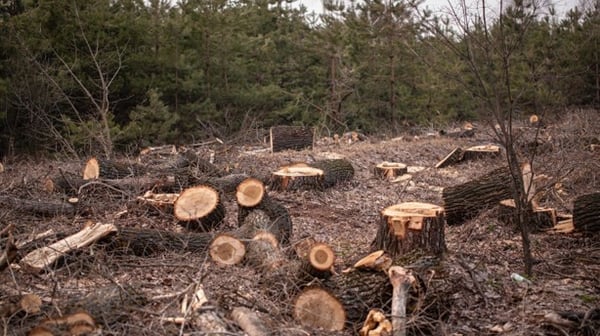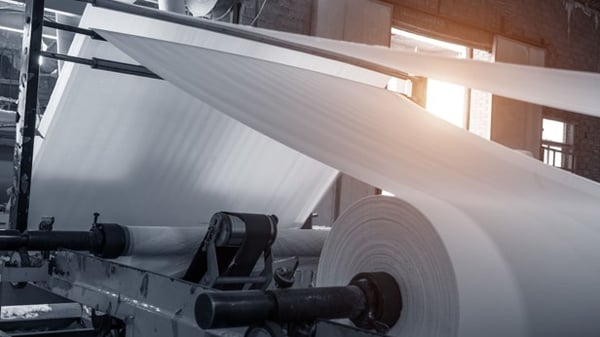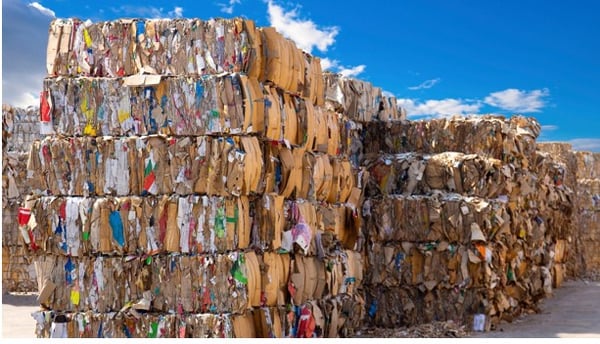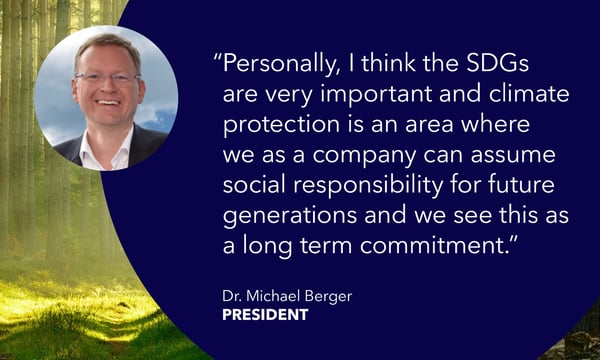Going paperless in your business can reduce your company's carbon footprint and help save our forests — and, ultimately, our planet. Whether you're looking at digitizing a single process or are ready to convert your entire office to paperless, DocuWare can help.
The environmental impact of paper
Producing paper requires a large number of trees and a significant quantity of chemicals and water. It also creates a great deal of pollution in the form of carbon emissions and waste. Dig deeper into the environmental impact of paper manufacturing and utilization with some specific statistics below.
Deforestation
Nearly all the paper generated in the United States comes from wood harvested through logging — and Americans use a lot of paper. According to the University of Southern Indiana, people in the United States use an average of 680 pounds of paper each year, and households in the nation throw away around 13,000 pieces of paper annually, including packaging and junk mail.
The issue isn't limited to one nation, as paper use across the globe relies on cutting down trees. Around 93% of paper comes from trees, and the global demand for pulp and paper is expected to double by 2060 — even in the so-called digital age.
The rapid deforestation that is, in large part, due to harvesting trees for paper has a negative impact on wildlife populations and increases the risk of major soil erosion. Residential communities in heavily logged areas may also see increases in both air and water pollution when trees, which have a natural ability to absorb carbon dioxide and emit oxygen, are removed. Most significantly, forest loss due to paper production contributes to climate change.
Paper production pollution
Paper production has an environmental impact even after trees are harvested. First, the manufacturing of paper and pulp contributes to pollution via greenhouse gas emissions. Within the paper industry, pulp and paper manufacturers account for around 70% of greenhouse gas emissions (the other 30% are related to other paper products).
Greenhouse gas emissions in the sector are trending down, as you can see in the chart below. But there's still plenty of room for improvement.
Metric tons of annual CO2 emissions (in millions) related to paper and pulp manufacturing
| 2012 | 30.228 |
| 2014 | 27.270 |
| 2016 | 26.779 |
| 2018 | 25.599 |
| 2020 | 24.502 |
Most paper in the U.S. is created through a process called kraft pulping. This process involves many stages of chemical washing to create wood pulp that is clean, white and ready for processing into paper. Only about half a tree ends up surviving the kraft process, and it requires around 98 tons of chemicals to create 1 ton of paper. Many of these chemicals, such as furan, chloroform and dioxin, are volatile and carry known health risks to humans.
Paper milling is also a huge draw on other natural resources, including clean water. It can require 2-13 liters of water to make a single piece of paper.
Paper waste and disposal pollution
Waste disposal is also a major environmental threat associated with paper. Around 50% of business waste is paper, and U.S. offices alone use more than 12 trillion sheets of paper every year. That's a lot of potential paper pollution.
Paper waste represents a substantial component of municipal solid waste in facilities nationwide; it turns out we’re printing more paper documents on average than we actually need. Then this paper is dumped into landfills. It starts to decompose, releasing toxic methane and potentially leeching printing ink into soil and water sources, causing greater environmental damage.
How going paperless benefits the environment.jpg?width=600&name=iStock-154894709%20(1).jpg)
Every business that commits to going paperless as much as possible has a positive impact on the environment. Let's look at some statistics about how your business can make a positive ecological impact by cutting down on paper.
Consider a hypothetical process that involves a minimum of 10 pieces of paper for each new customer someone signs up. Say, too, that the average customer service representative signs up five new people a day: that amounts to 50 pieces of paper daily. Multiply that by five days a week and 52 weeks in a year, that's 13,000 pieces of paper a year generated by each employee. Now, let's assume it’s a department of 10 people — then 130,000 pieces of paper a year are used for this single process.
It takes 10 to 20 trees to produce that much paper. Each tree produces enough oxygen for up to three people, so this one paper process means reducing oxygen production by 30 to 60 people's worth.
According to data published by North Carolina State University, 1 metric ton of paper creates around 942 kg of greenhouse gas emissions. A metric ton is around 200,000 sheets of paper. That means the hypothetical process described above would use over half a metric ton of paper — and just making the paper for that process would lead to more than 470 kg of greenhouse gas emissions.
These figures don't even account for the environmental impact of printing, storing, transporting, and, eventually, disposing of all this paper.
If this business process went paperless, it would save dozens of trees a year and cut down on emissions for the business. Now consider this: what if the business went paperless with even more processes? What processes can your business digitize to reduce deforestation, cut down on emissions and otherwise be leaner and greener?
How reducing your carbon footprint promotes business efficiency
It's not just about saving the planet, though. Partnering with DocuWare lets you leverage digital processes that reduce your reliance on paper and make your business more productive and efficient.
Increased employee engagement
Going paperless and increasing green initiatives can help you engage and hire top talent, and more engaged, skilled workers tend to drive more efficient productive processes.
Working for a company that has a sustainability initiative underway is increasingly important to employees:
- More than 60% of employees want to know more about their employers' sustainability programs
- Almost 70% say that sustainability is an important consideration when they apply for jobs
Why do employees care about a business's environmental footprint? Many take pride in where they work and can't do so if the company isn't aware of and working on its impact on the planet. Others say they want to personally make a positive impact on the environment, while many are worried about protecting the planet and its resources for the future.
Cost reduction
Going paperless lets you save more than the planet — it provides savings to your bottom line. Here are just some of the ways paperless processes drive cost efficiencies:
- No paper to store. Storing paper takes up space, and that costs money. Whether you're paying for a room full of file cabinets or an entire off-site archive warehouse, going paperless lets you eliminate the cost of these spaces.
- No paper to manage. When employees work with hard copies, they lose valuable time. File clerks, warehouse transport or simply hunting down a piece of paper when you’re minutes away from closing a deal takes time and labor.
- Reduced errors. Digital processes have lower overall error rates, especially when it comes to lost or misfiled information. Reduced error rates cut down on the need for rework and corrections.
- More engaged customers. It's much easier to keep clients and customers informed when you work with digital processes. You don't have to copy and mail or scan and email documents, which cuts down on time spent in communication processes. Going paperless also creates the opportunity for client portals, which let external stakeholders log in to review documents on their own timelines.
- Empowered employees. Digital documents are much easier to search and view in real-time than paper documents. Employees can easily find what they need to answer client questions while they're on the phone, and they can look up information without putting a task on hold. That leads to efficiencies, such as handling customer requests in a single call or getting more workflow tasks handled each hour.
Data security
Going paperless leads to tighter data security. While you do need to work with your vendor to appropriately set up software security to meet your organization's needs, cloud security is much better than the security associated with even a locked filing cabinet.
With DocuWare Cloud you can:
- Create role- or user-based permissions, so people can only access the information they need to do their jobs
- Track who accesses what documents for compliance and auditing purposes
- Record document versioning to ensure unwanted changes aren't made to documents
- Keep all documents in a single cloud repository, so they aren't misplaced, lost or stolen
Going paperless with DocuWare’s document management software
At DocuWare, we believe environmental governance and protection are important, and we partner with businesses to implement paperless processes that cut down on emissions and deforestation while driving internal savings and efficiencies. In this spirit, we're proud to be certified carbon transparent by Planetly. It's part of our commitment to the Sustainable Development Goals (SDGs) adopted by all United Nations member states in 2015.

Increase your environmental efforts, reduce paper waste and create more sustainability within your organization by starting your digital transformation. DocuWare's document management software can help. Learn how to create a paperless office in just 90 days or reach out to schedule a free demo of our software today.
While DocuWare solutions can help businesses reduce their paper usage, the tech business community as a whole can take more responsibility to help protect our planet. Any steps we take together to help lessen the effects of climate change are good ones.
Editor's note: This post has been updated for accuracy and new content has been added.

.jpg)
-1.png?width=370&name=DocuWare-planetly_carbontransparent-blue%20(1)-1.png)

